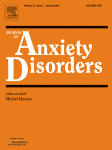Understanding Obsessive-Compulsive Disorder
Oct 03, 08



Understanding Obsessive-Compulsive Disorder
by Cohen, G. E.
A review of:
Abramowitz, J.S., Lackey, G. R., & Wheaton, M. G. (In-press). Obsessive-compulsive symptoms: The contribution of obsessional beliefs and experiential avoidance. Journal of Anxiety Disorders.
In their current study, Abramowitz, Lackey and Wheaton seek to compare a new theory for the primary mechanism underlying the symptoms of Obsessive-Compulsive Disorder (OCD) with the currently prevailing model. OCD includes symptoms of unwanted anxiety-evoking thoughts, images, and impulses (obsessions), and urges to perform behavioral or mental acts in an effort to reduce the anxiety felt (compulsions). Prevailing models of OCD state that obsessions result from maladaptive, negative interpretations of normal intrusive thoughts. 90% of the population experience some form of unwanted thought (Rachman & deSilva, 1978) but people with OCD treat these unwanted thoughts as highly significant and threatening, and so they feel these thoughts must be highly controlled. The misinterpretation of these thoughts leads to obsessional anxiety and rituals designed to control or minimize that anxiety.
Abramowitz, Lackey and Wheaton sought to determine if another mechanism, known as experiential avoidance (EA) better explain the symptoms and underlying beliefs associated with OCD. EA is characterized by an “unwillingness to endure upsetting emotions, thoughts, memories and other private experiences.” This unwillingness then leads to significant efforts to avoid or escape these experiences, resulting in compulsions (Hayes, Wilson, Gifford, Follette & Stroahl, 1996).
In order to explore the relationship between EA and OCD, Abramowitz, et al. recruited a sample of 353 undergraduate students who scored high on a self-report measure of obsessive compulsive symptoms. These undergraduate students then took 4 different self-report measures through an online system and these measures were analyzed to determine the extent to which they evidenced experiential avoidance versus maladaptive cognitions. It was found that participants that scored higher on symptoms of OCD also scored higher on measures of EA. However, it was unable to be determined if EA was specific to obsessive compulsive symptoms or if it is a characteristic of anxiety symptoms in general. Additionally, it was found that the maladaptive thought hypothesis better explained their results than did the experiential avoidance hypothesis. Indeed, dysfunctional beliefs regarding normal thoughts, and not the unwillingness to endure negative internal experiences, best explained many of the symptoms associated with OCD. These findings have important implications for the treatment of OCD and suggest that OCD may be best treated by helping an individual to change their pathological beliefs rather than learning to accept and endure the presence of these thoughts.
To cite this review, please use this reference:
Cohen, G., E. (2008). Understanding Obsessive Compulisve Disorder, Psychology Alert (1). http://psychologyalert.com/2008/10/understanding-obsessive-compulsive.html
Cohen, G., E. (2008). Understanding Obsessive Compulisve Disorder, Psychology Alert (1). http://psychologyalert.com/2008/10/understanding-obsessive-compulsive.html
